October 15th Scots Book of Days
October 15 – 1582 – Pope Gregory XIII implements the Gregorian calendar, replacing the older Julian calendar. In Italy, Poland, Portugal, and Spain, October 4 of this year is followed directly by October 15. So in those countries there was no October 5,6,7,8,9,10,11,12,13,14 1582. Scotland changed the beginning of the new year to January 1 in 1600, and in 1752, Scotland adopted the Gregorian calendar as part of the British empire. Eventually this Christian calendar, dating Jesus Christ’s birth is used by all people, tongues, kindred for aviation and computers. The calendar was first fixed, sixteen centuries earlier, by Julius Caesar for military necessity.
1715 Seaton house (Highlanders) reconnoitred by dragoons of Duke of Argyle. (TG68-316).
1741 HMS Sutherland a 50-gun fourth rate ship of the line of the Royal Navy, built at Rotherhithe according to the dimensions laid out in the 1733 proposals of the 1719 Establishment, and launched on 15 October 1741.
Sutherland was sold out of the navy in 1770. Participated in The Siege of Louisbourg 8 June–26 July 1758, which was a pivotal battle of the Seven Years’ War (known in the United States as the French and Indian War) in 1758 which ended the French colonial era in Atlantic Canada and led directly to the loss of Quebec in 1759 and the remainder of French North America the following year.
1747 Alexander Fraser Tytler, Lord Woodhouselee (15 October 1747 – 5 January 1813) was a Scottish lawyer, writer, and Professor of Universal History, and Greek and Roman Antiquities, in the University of Edinburgh. Senator of the College of Justice, and George Commissioner of Justiciary in Scotland. Tytler was a friend of Robert Burns, and prevailed upon Burns to remove lines from his poem “Tam o’ Shanter” which were insulting to lawyers and clerks. 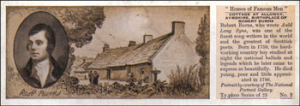 COTTAGE AT ALLOWAY, AYRSHIRE, BIRTHPLACE OF ROBERT BURNS. Robert Burns, who wrote Auld Lang Syne, was one of the finest song-writers in the world and the greatest of Scottish poets. Born in 1759, the hard-working country boy studied at night the national ballads and legends which he later came to express so beautifully. He died young, poor and little appreciated in 1796. Portrait by courtesy of The National Portrait Gallery.
COTTAGE AT ALLOWAY, AYRSHIRE, BIRTHPLACE OF ROBERT BURNS. Robert Burns, who wrote Auld Lang Syne, was one of the finest song-writers in the world and the greatest of Scottish poets. Born in 1759, the hard-working country boy studied at night the national ballads and legends which he later came to express so beautifully. He died young, poor and little appreciated in 1796. Portrait by courtesy of The National Portrait Gallery.
www.englishteastore.com/typhoo-history-cards
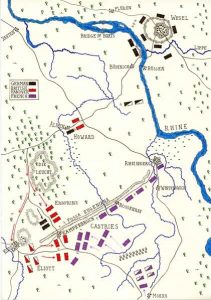 1760 Battle of Kloster Kamp, Rhine and Lippe River Germany. Seven Years War. 25th Foot with 209 casualities; now the King’s Own Scottish Borders. 87th Highlanders; disbanded after the war.
88th Highlanders; disbanded after the war.
1760 Battle of Kloster Kamp, Rhine and Lippe River Germany. Seven Years War. 25th Foot with 209 casualities; now the King’s Own Scottish Borders. 87th Highlanders; disbanded after the war.
88th Highlanders; disbanded after the war.
Battle of Kloster Kamp
1764 – Edward Gibbon observes a group of friars singing in the ruined Temple of Jupiter in Rome, which inspires him to begin work on The History of the Decline and Fall of the Roman Empire. Published by Andrew Millar’s (by the Strand in London) partner, after Millar’s demise.
1818 Irvin McDowell (October 15, 1818 – May 4, 1885) One of Lincoln’s ‘Scots’ Generals. Major General best known for his defeat in the First Battle of Bull Run July 21, 1861, the first large-scale battle of the American Civil War. 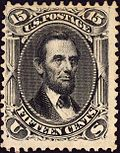 Commands included Army of Northeastern Virginia, I Corps, Army of the Potomac, III Corps, Army of Virginia, Department of the Pacific, Department of California, Department of the West. Battles included Battle of Fairfax Courthouse, Battle of Vienna Virginia, Battle of Arlington Mills, Battle of Blackburn’s Ford, First Battle of Bull Run, Second Battle of Bull Run.
Commands included Army of Northeastern Virginia, I Corps, Army of the Potomac, III Corps, Army of Virginia, Department of the Pacific, Department of California, Department of the West. Battles included Battle of Fairfax Courthouse, Battle of Vienna Virginia, Battle of Arlington Mills, Battle of Blackburn’s Ford, First Battle of Bull Run, Second Battle of Bull Run.
1866 stamp. Lincoln 15 cents.
1863 – American Civil War: The H. L. Hunley, the first submarine to sink a ship, sinks during a test, killing its inventor, Horace L. Hunley.
1864 – American Civil War: The Battle of Glasgow is fought, resulting in the surrender of Glasgow, Missouri, and its Union garrison, to the Confederacy.
 1908 John Kenneth Galbraith October 15, 1908 – April 29, 2006), United States Ambassador to India under Kenned. Parents Archibald “Archie” Galbraith and Sarah Catherine Kendall. (clan Galbraith) Galbraith Crest: A bear’s head couped Argent muzzled Azure. Motto: AS OBICE SUAVIOR.
[From Latin: “More smooth from an obstacle”]. The chiefs were The Galbraith of Culcreuch (untraceable since about 1700).
1908 John Kenneth Galbraith October 15, 1908 – April 29, 2006), United States Ambassador to India under Kenned. Parents Archibald “Archie” Galbraith and Sarah Catherine Kendall. (clan Galbraith) Galbraith Crest: A bear’s head couped Argent muzzled Azure. Motto: AS OBICE SUAVIOR.
[From Latin: “More smooth from an obstacle”]. The chiefs were The Galbraith of Culcreuch (untraceable since about 1700).
1943 Admiral Sir Andrew B. Cunningham (clan Cunningham) filled the United Kingdom Navy’s most senior position First Sea Lord, on the 15th, replacing Adm of the Fleet Sir Dudley Pound, First Sea Lord since 1939, who suffered a stroke in August 1943 at the time of the Quebec conference. www.naval-history
1956 – Fortran, the first modern computer language, is shared with the coding community for the first time.
1959 October 15. President David Oman McKay (clan McKay) ordained Howard W Hunter (clan Hunter) as the 74th Apostle (in modern dispensation) and set Howard apart as a member of the Quorum of the Twelve. Howard W. Hunter becomes 14th President of the Church of Jesus Christ of Latter Day Saints in 1994. The Hunters are from Paisley Renfrewshire Scotland. The McKays are from Caithness Scotland. President Howard W. Hunter: The Lord’s “Good and Faithful Servant” Ensign Apr 1995.
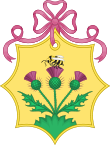 1959 Sarah Ferguson (see clans) born 15 October 1959). Sarah, Duchess of York (Sarah Margaret; née Ferguson;) is a descendant of King Charles II of England via two of his natural sons, Charles Lennox, 1st Duke of Richmond, and James Scott, 1st Duke of Monmouth. She is the 2nd great-granddaughter of William Montagu Douglas Scott 6th Duke of Buccleuch (thus a cousin to Rudyard Kipling), a great-granddaughter of Meryvin Wingfield the 8th Viscount Powerscourt and a direct descendant of Georgiana Cavendish, Duchess of Devonshire. Her paternal grandmother was Lady Marian Louisa Montagu Douglas Scott, a first cousin of Lady Alice Christabel Montagu Douglas Scott, who married Prince Henry, Duke of Gloucester, an uncle of Queen Elizabeth II.
1959 Sarah Ferguson (see clans) born 15 October 1959). Sarah, Duchess of York (Sarah Margaret; née Ferguson;) is a descendant of King Charles II of England via two of his natural sons, Charles Lennox, 1st Duke of Richmond, and James Scott, 1st Duke of Monmouth. She is the 2nd great-granddaughter of William Montagu Douglas Scott 6th Duke of Buccleuch (thus a cousin to Rudyard Kipling), a great-granddaughter of Meryvin Wingfield the 8th Viscount Powerscourt and a direct descendant of Georgiana Cavendish, Duchess of Devonshire. Her paternal grandmother was Lady Marian Louisa Montagu Douglas Scott, a first cousin of Lady Alice Christabel Montagu Douglas Scott, who married Prince Henry, Duke of Gloucester, an uncle of Queen Elizabeth II.
Sarah’s arms, Or, growing out of a mound between two leaves three thistle stalks Vert blossomed Purple all conjoined in base, alighting on the middle blossom a honeybee Or and Sable winged Argent. These arms were granted to her father, Ronald Ferguson. She bears them on a lozenge.
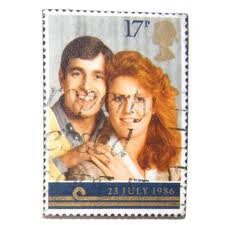 Happier Days photo of newlyweds Duke (Prince Andrew) and Duchess of York 17 March 1986 to 1996. Queen’s permission is required for marriage by children of the monarch by a British law, the Royal Marriages Act 1772), and Acts dating to Henry 8th. Wikipedia.
Happier Days photo of newlyweds Duke (Prince Andrew) and Duchess of York 17 March 1986 to 1996. Queen’s permission is required for marriage by children of the monarch by a British law, the Royal Marriages Act 1772), and Acts dating to Henry 8th. Wikipedia.
1997 – The Cassini probe launches from Cape Canaveral on its way to Saturn.
1966 Governor’s Palace Williamsburg Virginia added to United states National Register of Historic Places. The red brick palace, rebuilt in 1931-1934, was patterned after the one originally built circa 1706, and that one was patterned closely after Hampton Hall near London, although on half scale. The London Hampton Hall, on the Thames River, was built for Cardinal Woolsey circa 1520, seized by Henry the Eighth a few years later, and then abandoned after Henry died about 1548. A century and a half later, the new king and Queen, William Stewart and Mary Stewart, renovated the London Hampton Hall for a major palace and residence. Hampton Hall is now a tourist trap. The Virginia colony moved the capital from Jamestown, up river to a space named Williamsburg for the King. A feature of both the Governor’s Palace and Hampton Hall was a brace of pistols, muskets, and weapons decorating the walls for use against the commoners. English rulers prohibited gun ownership of its populace, because it did not trust its population. Scotland’s tradition was different, as it trusted its clans, which were hired out as mercenaries. Colonial Virginia did not ban guns for its colonists.
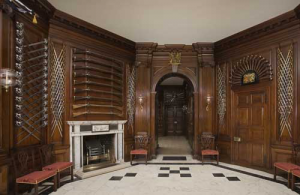 Williamsburg’s 1931 Governor’s palace with reproductions of 9 muskets over the fire place, 20 pistols in a half moon arc on the right over a door, 23 crossed cutlasses, 96 saber swords. The 1695 London Hampton Hall has an almost identical display, and is also a tourist trap. The story goes in 1775, as the British rule collapsed in Virginia, the Governor fled the palace and the weapons, left behind were seized by the patriots and committee of safety. Gun control.
Williamsburg’s 1931 Governor’s palace with reproductions of 9 muskets over the fire place, 20 pistols in a half moon arc on the right over a door, 23 crossed cutlasses, 96 saber swords. The 1695 London Hampton Hall has an almost identical display, and is also a tourist trap. The story goes in 1775, as the British rule collapsed in Virginia, the Governor fled the palace and the weapons, left behind were seized by the patriots and committee of safety. Gun control.
 1999 Gregory’s Two Girls Eighteen years after the events of Gregory’s Girl.
1999 Gregory’s Two Girls Eighteen years after the events of Gregory’s Girl.
DVD.
2001 – NASA’s Galileo spacecraft passes within 112 miles of Jupiter’s moon Io.
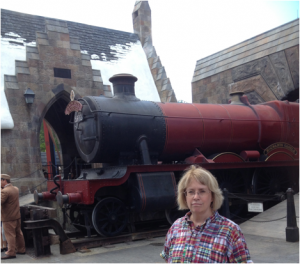 2012 Humor, completely spurious. It could have happened while filming one of the Harry Potter scenes in Scotland, that Wallace, an Englishman, and Gretchen sat together in a carriage in a train going through the Highlands of Scotland. Suddenly the train went through a tunnel and, as it was an old style steam train, there were no lights in the carriages and it went completely dark. Then there was this kissing noise and the sound of a really loud slap. When the train came out of the tunnel, Gretchen and Wallace were sitting as if nothing had happened and the English had his hand against his face as he had been slapped.
The English thought: “The Scot must have kissed Gretchen and she missed him and slapped me instead. ” Gretchen was thinking: ” The Englishman must have tried to kiss me and actually kissed the Scot and got slapped for it.”
And Wallace was thinking: “This is magic. The next time the train goes through a tunnel I’ll make that kissing noise and slap that English fool again.’’
2012 Humor, completely spurious. It could have happened while filming one of the Harry Potter scenes in Scotland, that Wallace, an Englishman, and Gretchen sat together in a carriage in a train going through the Highlands of Scotland. Suddenly the train went through a tunnel and, as it was an old style steam train, there were no lights in the carriages and it went completely dark. Then there was this kissing noise and the sound of a really loud slap. When the train came out of the tunnel, Gretchen and Wallace were sitting as if nothing had happened and the English had his hand against his face as he had been slapped.
The English thought: “The Scot must have kissed Gretchen and she missed him and slapped me instead. ” Gretchen was thinking: ” The Englishman must have tried to kiss me and actually kissed the Scot and got slapped for it.”
And Wallace was thinking: “This is magic. The next time the train goes through a tunnel I’ll make that kissing noise and slap that English fool again.’’
http://www.fife.50megs.com/scottish-humour2.htm
Who kissed whom? standing outside of Hogwarts Express 5972 just coming out of the tunnel. Fictional Hogwarts is in Scotland. Universal Tour Orlando, September 2013.
Disclaimer: The author of each article published on this web site owns his or her own words. The opinions, beliefs and viewpoints expressed by the various authors and forum participants on this site do not necessarily reflect the opinions, beliefs and viewpoints of Utah Standard News or official policies of the USN and may actually reflect positions that USN actively opposes. No claim in public domain or fair use. © John Choate.
Utah Standard News depends on the support of readers like you.
Good Journalism requires time, expertise, passion and money. We know you appreciate the coverage here. Please help us to continue as an alternative news website by becoming a subscriber or making a donation. To learn more about our subscription options or make a donation, click here.
To Advertise on UtahStandardNews.com, please contact us at: ed@utahstandardnews.com.


Comments - No Responses to “October 15th Scots Book of Days”
Sure is empty down here...